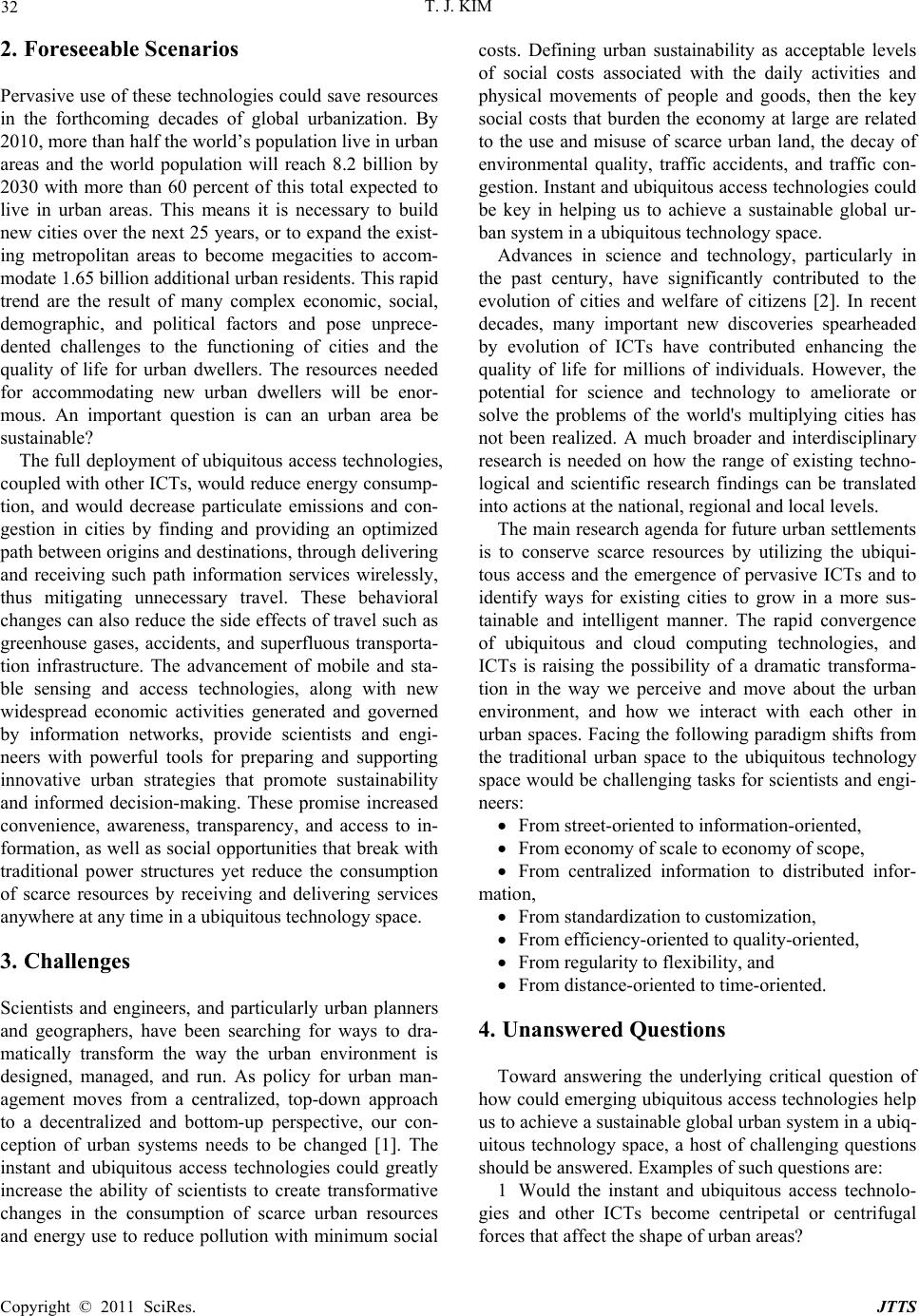
32 T. J. KIM
2. Foreseeable Scenarios
Pervasive use of these technologies could save resources
in the forthcoming decades of global urbanization. By
2010, more than half th e world’ s populatio n live in urban
areas and the world population will reach 8.2 billion by
2030 with more than 60 percent of this total expected to
live in urban areas. This means it is necessary to build
new cities over the next 25 years, or to expand the ex ist-
ing metropolitan areas to become megacities to accom-
modate 1.65 billion additional urban residents. This rapid
trend are the result of many complex economic, social,
demographic, and political factors and pose unprece-
dented challenges to the functioning of cities and the
quality of life for urban dwellers. The resources needed
for accommodating new urban dwellers will be enor-
mous. An important question is can an urban area be
sustainable?
The full deployment of ubiquitous access technologies,
coupled with other ICTs, would reduce energy consump-
tion, and would decrease particulate emissions and con-
gestion in cities by finding and providing an optimized
path between origins and destinations, through delivering
and receiving such path information services wirelessly,
thus mitigating unnecessary travel. These behavioral
changes can also reduce the side effects of travel such as
greenhouse gases, accidents, and superfluous transporta-
tion infrastructure. The advancement of mobile and sta-
ble sensing and access technologies, along with new
widespread economic activities generated and governed
by information networks, provide scientists and engi-
neers with powerful tools for preparing and supporting
innovative urban strategies that promote sustainability
and informed decision-making. These promise increased
convenience, awareness, transparency, and access to in-
formation, as well as social opportunities that break with
traditional power structures yet reduce the consumption
of scarce resources by receiving and delivering services
anywhere at any time in a ubiquitous technology space.
3. Challenges
Scientists and engineers, and particularly urban planners
and geographers, have been searching for ways to dra-
matically transform the way the urban environment is
designed, managed, and run. As policy for urban man-
agement moves from a centralized, top-down approach
to a decentralized and bottom-up perspective, our con-
ception of urban systems needs to be changed [1]. The
instant and ubiquitous access technologies could greatly
increase the ability of scientists to create transformative
changes in the consumption of scarce urban resources
and energy use to reduce pollution with minimum social
costs. Defining urban sustainability as acceptable levels
of social costs associated with the daily activities and
physical movements of people and goods, then the key
social costs that burden the economy at large are related
to the use and misuse of scarce urban land, the decay of
environmental quality, traffic accidents, and traffic con-
gestion. Instant and ubiquitous access technologies could
be key in helping us to achieve a sustainable global ur-
ban system in a ubiquitous techno logy space.
Advances in science and technology, particularly in
the past century, have significantly contributed to the
evolution of cities and welfare of citizens [2]. In recent
decades, many important new discoveries spearheaded
by evolution of ICTs have contributed enhancing the
quality of life for millions of individuals. However, the
potential for science and technology to ameliorate or
solve the problems of the world's multiplying cities has
not been realized. A much broader and interdisciplinary
research is needed on how the range of existing techno-
logical and scientific research findings can be translated
into actions at the national, regional and local leve ls.
The main research agenda for future urban settlements
is to conserve scarce resources by utilizing the ubiqui-
tous access and the emergence of pervasive ICTs and to
identify ways for existing cities to grow in a more sus-
tainable and intelligent manner. The rapid convergence
of ubiquitous and cloud computing technologies, and
ICTs is raising the possibility of a dramatic transforma-
tion in the way we perceive and move about the urban
environment, and how we interact with each other in
urban spaces. Facing the following paradigm shifts from
the traditional urban space to the ubiquitous technology
space would be challenging tasks for scientists and engi-
neers:
From street-oriented to information-oriented,
From economy of scale to economy of scope,
From centralized information to distributed infor-
mation,
From standardization to customization,
From efficiency-oriented to quality-oriented,
From regularity to flexibility, and
From distance-oriented to time-oriented.
4. Unanswered Questions
Toward answering the underlying critical question of
how could emerging ubiquitous access technologies help
us to achieve a sustainable global urban system in a ubiq-
uitous technology space, a host of challenging questions
should be answered. Examples of such questions are:
1 Would the instant and ubiquitous access technolo-
gies and other ICTs become centripetal or centrifugal
forces that affect the shape of urban areas?
Copyright © 2011 SciRes. JTTS